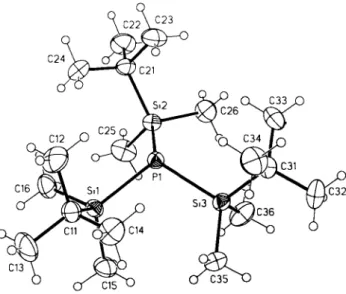Zeitschrift für Kristallographie - New Crystal Structures 212, 249-250
© by R. Oldenbourg Verlag, München 1997
249
Crystal structure of tris(ter^butyl-dimethylsilyl)phosphine, ((C
4H
9)(CH
3)2Si)
3P
M. Nieger, E. Niecke and S. Dany
Universität Bonn. Institut für Anorganische Chemie, Gerhard-Domagk-Str. 1, D-53121 Bonn, Germany Received September 2, 1996, CSD-No. 402619
Table 2. Final atomic coordinates and displacement parameters (in A2)
Source of material: Single crystals of the title compound (see ref.
2) were obtained by crystallization from diethylether (see ref. 6).
Compared to the parent system (H3SO3P (see réf. 1) and the tris(trimethylsilyl)phosphine (see ref. 2) the S i - P - S i angles are widened (96° vs. 106° vs. 110°). Due to the bulky substituents the phosphorus atom is less pyramidalized. The same effect is ob- served in the structures of trialkylphosphines (see refs. 3-5).
C18H45PS13, monoclinic, P\2\!n\ (No. 14), a =10.979(1) Â, b =17.078(3) Â, c =13.797(2) Â, β =110.42(1)°, V =2424.4 Â3, Ζ =4, R(F) =0.042, Λν/F2, all data) =0.117.
Table 1. Parameters used for the X-ray data collection
Crystal: colorless plate, size 0.08 χ 0.20 χ 0.40 mm Wavelength: Cu Ka radiation (1.54178 Â)
μ: 23.82 cm"1
Diffractometer: Enraf-Nonius CAD4
Scan mode: 2θ/ω
^measurement- 193 Κ
26max: 112°
N(hkl)umque'· 3143
Criterion for /<>: /o > 2 σ(/0)
Ν (param)repneir· 199
Programs: SHELXS-86, SHELXL-93
Atom Site X y ζ í/iso
H(I2A) Ae 0.1256(4) 0.2368(2) 0.7148(2) 0.076 H(12B) Ae 0.2616(4) 0.2127(2) 0.7046(2) 0.076 H(12C) Ae 0.2019(4) 0.1611(2) 0.7739(2) 0.076 H(13A) Ae -0.0601(4) 0.0754(2) 0.5707(3) 0.087 H(13B) Ae -0.0696(4) 0.1507(2) 0.6366(3) 0.087 H(13C) Ae 0.0120(4) 0.0759(2) 0.6934(3) 0.087 H(14A) Ae 0.1552(3) 0.0405(2) 0.5535(3) 0.071 H(14B) Ae 0.2197(3) 0.0430(2) 0.6770(3) 0.071 H(14C) Ae 0.2794(3) 0.0947(2) 0.6076(3) 0.071 H(15A) Ae 0.0052(3) 0.1023(2) 0.3671(2) 0.068 H(1SB) Ae -0.0762(3) 0.1795(2) 0.3195(2) 0.068 H(15C) Ae -0.1197(3) 0.1247(2) 0.3957(2) 0.068 H(16A) Ae 0.0044(3) 0.3166(2) 0.5706(3) 0.068 H(16B) Ae -0.1201(3) 0.2611(2) 0.5253(3) 0.068 H(16C) Ae -0.0765(3) 0.3159(2) 0.4491(3) 0.068 H(22A) Ae 0.2968(4) 0.5386(2) 0.4476(3) 0.087 H(22B) Ae 0.2855(4) 0.5643(2) 0.5557(3) 0.087 H(22C) Ae 0.1581(4) 0.5389(2) 0.4616(3) 0.087 H(23A) Ae 0.4666(3) 0.4381(2) 0.5463(3) 0.071 H(23B) Ae 0.4318(3) 0.3765(2) 0.6201(3) 0.071 H(23C) Ae 0.4483(3) 0.4673(2) 0.6505(3) 0.071 H(24A) Ae 0.1064(3) 0.4381(2) 0.5736(3) 0.079 H(24B) Ae 0.2315(3) 0.4673(2) 0.6670(3) 0.079 H(24C) 4e 0.2151(3) 0.3765(2) 0.6365(3) 0.079 H(25A) Ae -0.0151(3) 0.3888(2) 0.3728(3) 0.076 H(25B) Ae 0.0176(3) 0.3668(2) 0.2718(3) 0.076 H(25C) Ae 0.0382(3) 0.4546(2) 0.3151(3) 0.076 H(26A) Ae 0.4078(3) 0.3845(2) 0.3770(3) 0.068 H(26B) Ae 0.3080(3) 0.4518(2) 0.3179(3) 0.068 H(26C) Ae 0.2875(3) 0.3640(2) 0.2746(3) 0.068 H(32A) Ae 0.5172(4) 0.1382(2) 0.2893(3) 0.096 H(32B) Ae 0.5056(4) 0.0615(2) 0.3521(3) 0.096 H(32C) Ae 0.6381(4) 0.1106(2) 0.3874(3) 0.096 H(33A) Ae 0.5341(3) 0.2712(2) 0.3737(3) 0.078 H(33B) Ae 0.6538(3) 0.2388(2) 0.4692(3) 0.078 H(33C) Ae 0.5317(3) 0.2776(2) 0.4888(3) 0.078 H(34A) Ae 0.4938(3) 0.0743(2) 0.5302(3) 0.080 H(34B) Ae 0.5073(3) 0.1587(2) 0.5831(3) 0.080 H(34C) Ae 0.6294(3) 0.1200(2) 0.5635(3) 0.080 H(35A) Ae 0.2677(3) 0.0491(2) 0.4351(3) 0.066 H(35B) Ae 0.2807(3) 0.0378(2) 0.3239(3) 0.066 H(35C) Ae 0.1490(3) 0.0717(2) 0.3326(3) 0.066 H(36A) Ae 0.2886(4) 0.2602(2) 0.2323(2) 0.078 H(36B) Ae 0.1622(4) 0.2059(2) 0.2036(2) 0.078 H(36C) Ae 0.2939(4) 0.1720(2) 0.1949(2) 0.078
250
Tris(tórí-butyl-dimethylsilyl)phosphineTable 3. Final atomic coordinates and displacement parameters (in À2)
Atom Site X y ζ Un Un C/33 Un U13 Uiì
P(l) 4e 0.24613(6) 0.25031(4) 0.47934(5) 0.0262(4) 0.0238(4) 0.0283(4) -0.0007(3) 0.0119(3) 0.0001(3) Si(l) 4e 0.06020(7) 0.20372(4) 0.49400(6) 0.0243(4) 0.0318(4) 0.0277(4) -0.0028(3) 0.0092(3) -0.0004(3) C ( l l ) 4e 0.1092(3) 0.1421(2) 0.6165(2) 0.040(2) 0.037(2) 0.029(2) -0.006(1) 0.017(1) 0.002(1) C(12) 4e 0.1811(4) 0.1927(2) 0.7110(2) 0.066(2) 0.058(2) 0.028(2) -0.004(2) 0.016(2) -0.001(2) C(13) 4e -0.0132(4) 0.1079(2) 0.6306(3) 0.062(2) 0.065(2) 0.060(2) -0.014(2) 0.038(2) 0.013(2) C(14) 4e 0.1990(3) 0.0739(2) 0.6134(3) 0.064(2) 0.040(2) 0.038(2) 0.005(2) 0.020(2) 0.011(2) C(15) 4e -0.0452(3) 0.1456(2) 0.3806(2) 0.035(2) 0.058(2) 0.038(2) -0.012(2) 0.006(2) -0.008(2) C(16) 4e -0.0456(3) 0.2838(2) 0.5118(3) 0.033(2) 0.049(2) 0.059(2) 0.005(2) 0.022(2) 0.003(2) Si(2) 4e 0.21453(7) 0.37455(4) 0.41774(6) 0.0295(4) 0.0265(4) 0.0273(4) 0.0001(3) 0.0068(3) 0.0027(3) C(21) 4e 0.2721(3) 0.4432(2) 0.5336(2) 0.035(2) 0.027(2) 0.039(2) -0.003(1) 0.010(1) -0.005(1) C(22) 4e 0.2512(4) 0.5291(2) 0.4962(3) 0.062(2) 0.026(2) 0.084(3) 0.000(2) 0.022(2) -0.007(2) C(23) 4e 0.4180(3) 0.4301(2) 0.5930(3) 0.039(2) 0.046(2) 0.047(2) -0.008(2) 0.003(2) -0.008(2) C(24) 4e 0.1997(3) 0.4301(2) 0.6096(3) 0.058(2) 0.055(2) 0.049(2) -0.010(2) 0.025(2) -0.024(2) C(25) 4e 0.0434(3) 0.3991(2) 0.3344(3) 0.043(2) 0.048(2) 0.048(2) 0.004(2) -0.002(2) 0.015(2) C(26) 4e 0.3166(3) 0.3963(2) 0.3372(3) 0.057(2) 0.040(2) 0.043(2) -0.003(2) 0.023(2) 0.010(2) Si(3) 4e 0.30905(7) 0.17250(4) 0.37184(6) 0.0286(4) 0.0299(4) 0.0244(4) -0.0004(3) 0.0084(3) -0.0033(3) C(31) 4e 0.4933(3) 0.1646(2) 0.4291(2) 0.031(2) 0.037(2) 0.043(2) 0.003(1) 0.016(1) -0.004(1) C(32) 4e 0.5431(4) 0.1141(2) 0.3580(3) 0.053(2) 0.073(3) 0.079(3) 0.009(2) 0.039(2) -0.018(2) C(33) 4e 0.5593(3) 0.2454(2) 0.4413(3) 0.030(2) 0.057(2) 0.069(2) -0.007(2) 0.019(2) -0.007(2) C(34) 4e 0.5347(3) 0.1259(2) 0.5362(3) 0.039(2) 0.057(2) 0.053(2) 0.012(2) 0.003(2) 0.006(2) C(35) 4e 0.2438(3) 0.0707(2) 0.3651(3) 0.050(2) 0.035(2) 0.049(2) -0.007(2) 0.020(2) -0.013(2) C(36) 4e 0.2572(4) 0.2067(2) 0.2342(2) 0.074(2) 0.055(2) 0.024(2) 0.007(2) 0.014(2) -0.002(2)
References
1. Blake, A. J.; Ebsworth, Ε. Α. V.; Henderson, S. G. D.: Structure of Trisilyl- phosphine, P(SiH3)3, at 100 K. Acta Crystallogr. C47 (1991) 486-489.
2. Bender, H.: Dilithium-silylphosphide, 13-Diphospha-2-sila-allyl-Systeme und Phosphino-phosphasilene: Wege zu neuen Phospbor-Silizium-(3pTt- 3pre)-Bindungssystemen, flue Struktur, Reaktivität und spektioskopischen Eigenschaften. Dissertation, Universität Bonn, Gemiany 1993.
3. Bruckmann, J.; Krüger, C.: Tris(n-butyl)phosphine, Tris(fe/t-butyl) phos- pfaine and Tris(trimetliylsilyl)phosphine. Acta Crystallogr. CSI (199S)
1152-1155.
4. Bnickmann, J., Krüger, C.: Trimethylphosphine and Triethylphosphine in the Solid State. Acta Crystallogr. CSI (1995) 1155-1158.
5. Bruckmann, J.; Krüger, C.: Tris(n-propyl)phosphine and Tris(iso-propyl)- phosphine. Acta Crystallogr. C52 (19%) 1733-1736.
6. Dany, S.: Unpublished results.
7. Sheldrick, G. M.: SHELXS-86. Program for the solution of crystal struc- tures. University of Göttingen, Germany 1986.
8. Sheldrick, G. M.: SHELXL-93, a program for refining crystal structures.
University of Göttingen, Germany 1993.

